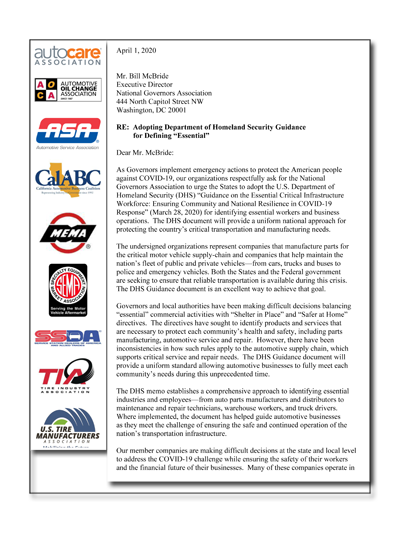Business groups ask states to follow federal guidance on essential business and critical infrastructure to eliminate confusion and supply chain disruptions.
Separately, a national group of business associations and a group of automotive repair and supplier associations sent letters to state leaders calling for consistent application of essential business designations based upon guidance provided by the federal government.
 A group of nine automotive repair and aftermarket supplier groups including the Automotive Service Association (ASA), the Auto Care Association, , Motor & Equipment Manufacturers Association (MEMA) the Specialty Equipment Market Association (SEMA) and others, in a letter April 1, issued a call for consistency that will allow automotive repair businesses as well as distributors and manufacturers that supply them to operate based upon federal guidance.
A group of nine automotive repair and aftermarket supplier groups including the Automotive Service Association (ASA), the Auto Care Association, , Motor & Equipment Manufacturers Association (MEMA) the Specialty Equipment Market Association (SEMA) and others, in a letter April 1, issued a call for consistency that will allow automotive repair businesses as well as distributors and manufacturers that supply them to operate based upon federal guidance.
In a joint letter to the National Governors Association on March 26, the Business Roundtable, NAM and the U.S. Chamber of Commerce called on states, territories and the District of Columbia to follow guidance from the federal government.
While some states have incorporated guidance from the Department of Homeland Security’s Cybersecurity and Infrastructure Security Agency (CISA) identifying critical infrastructure workers and businesses who are exempt from stay-at-home or business closure orders, several states have developed their owns lists independently, and have made numerous modifications since introduction.
The issue has become more critical as more than 30 states currently have announced restrictions on business operations or stay at home orders at the local or state level.
Automotive repair and maintenance facilities are included with the Transportation and Logistics sector of the CISA guidance. Importantly, the CISA list also includes a critical manufacturing sector that includes materials and products needed for categories such as medical supply chains as well as transportation are included. Financial services, including insurance services, are also included in the CISA critical infrastructure workforce list.
According to the automotive group’s letter, “Governors and local authorities have been making difficult decisions balancing ‘essential’ commercial activities with ‘Shelter in Place’ and ‘Safer at Home’ directives. The directives have sought to identify products and services that are necessary to protect each community’s health and safety, including parts manufacturing, automotive service and repair. However, there have been inconsistencies in how such rules apply to the automotive supply chain, which supports critical service and repair needs. The DHS Guidance document will provide a uniform standard allowing automotive businesses to fully meet each community’s needs during this unprecedented time.”
The letter continued, “The DHS memo establishes a comprehensive approach to identifying essential industries and employees—from auto parts manufacturers and distributors to maintenance and repair technicians, warehouse workers, and truck drivers. Where implemented, the document has helped guide automotive businesses as they meet the challenge of ensuring the safe and continued operation of the nation’s transportation infrastructure.”
According to the business groups’ joint letter, “To help our continued response, we have called on state and local governments to take a uniform approach that allows ‘essential business’ and “critical infrastructure” to operate as they issue stay-in-place orders. Many governors and local leaders have done this by incorporating by reference the guidance from the Department of Homeland Security’s Cybersecurity and Infrastructure Security Agency (CISA) on the identification of essential critical infrastructure workers in their orders. This direct adoption of the federal guidance is critical for continuity of operations and allows businesses and workers to focus on serving their communities and the nation during these unprecedented times. We thank the leaders who have taken this collaborative and balanced approach and urge others to follow this strategic model. We also thank you for including language in support of the CISA guidance in your overview memorandum to stakeholders.